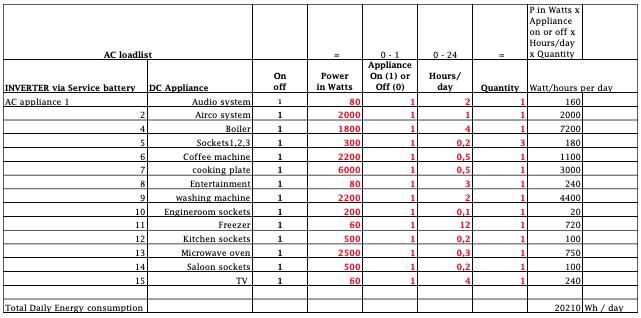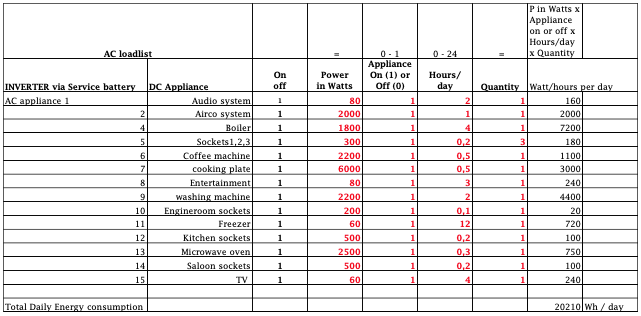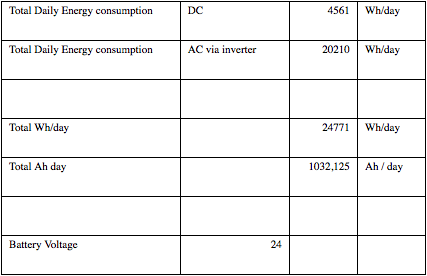Understanding the design process:
Make a plan before buying and installing your battery based hybrid energy system. If you don’t plan the design process of your energy system carefully, your investment may turn out to be sub-optimal and more expensive than intended!
The following steps should be followed to design your hybrid energy system.This is valid either for mobile, marine, off-grid or other energy systems including solar PV.
When designing a energy system follow the design steps. Of course you need to do it precisely. Be aware these are guidelines for designers to understand the overall process of putting together the energy system.
Designing the system is not a one-time shot. Try different assumptions to see the results and compare these to get to the optimum design.
The design steps are as follows:
- Calculation of the energy load and selection of the system voltage
- For a solar powered system, survey of the solar resources and selection of the PV modules are needed
- Sizing and selection of the batteries
- Sizing and selection of the inverter (and solar charge controller when solar PV is in the system)
- Sizing and Selection of the battery charger
- Sizing and selection of the DC or AC generator when required
- Sizing and selection of AC and DC distribution, battery monitoring and system monitoring and control
- Finally when system has been designed. The selection and sizing of wiring, fusing, switches and installation components is required.
- After installation system check and initial start-up and first inspection/commissioning of the system
- During the years we advise you to do regular inspection of the system and be aware of the required maintenance for the system.
Planning considerations
- The energy system is a relatively large investment. This is a primary reason why people often can not afford to buy a perfectly sized energy system all at once. If this is the case plan the system to be build up in phases. Starting with fewer appliances and increasing energy use when the system has grown or is completed.
- When planning a energy system, keep in mind that in most cases energy consumption will grow. Keep in mind adding system components such as batteries is not always possible seen from technical aspects as well as from a size/ space constraints.
- It is advisable to have a floorplan/ installation plan showing where the system needs to be installed. So there is clear picture what equipment with their physical sizes will fit.
- Keep systems as simple as possible. The more complex you make the system, the greater the chance that it goes wrong or even worse you can’t get it to work. Another problem that may occur is the operator/end user/ boat owner of the system does not understand the system and will complain abot this even in the public domain. This will result in after sales and service calls and might harm the image of the installer or even the Whisper Power brand.
- If you are comparing systems of different brands, check the quality, performance, functionality rather than only go for the lowest price.
- Estimate loads realistically and carefully. Over-estimation of the load will increase the costs of the system significantly. Under estimation of the load will result in continuous battery problems and/or long running hours of the genset. Considering (critical) professional applications: worst case the job to be carried out is stopped as there is shortage on energy.
System Voltage
The system voltage is the nominal voltage at which batteries , inverters and charge regulators work. In most cases this is a 12, 24 or 48 Volt DC voltage. We offer for all these battery voltage levels energy systems and products. In cases where the power need is high, we choose 24Volt DC, or in some cases even 48Volt DC systems depending on specific requirements and power needs.

Total daily system energy requirement – important calculations
How much energy is needed to power a system each day?
Start with making a list of all the lights and other appliances which need to be powered. The more appliances you can get with a low energy requirement the better it is. The daily load energy demand is the amount of energy required each day to provide energy for the load like lamps and other appliances. This is measured in watt-hours and or amp-hours. The sum of all individual appliances energy consumption together gives the daily use. Separate the appliances powered by DC (direct connected to the battery /in most cases 12 or 24 Volt sometimes 48 Volt) and AC appliances which are connected to an inverter and or generator or even grid power when this is available. Calculation of the load energy and selection of the system VoltageThere are two common methods of calculation the energy consumption in battery based energy systems. The two methods are:
- Amp-hour
- Watt-hour

If you do the calculation properly both of the calculations come to the same energy usage.
In most cases calculations are made with the Amp-hour method which is often used in the professional and recreational applications in mobile and marine environment. For solar related systems often the Watt-hour method. This is easier as the energy production of solar modules with MPPT charge controllers can be calculated with the Watt-hour method. Finally we convert Watt hour to Amp hour when we have to size the battery anyway.
We prefer to do both when the systems are getting larger. The conversion from one to another can be done easily.
Calculate the daily load energy demand in Watt-hours / day.
You can fill in the DC loadlist were we put in the appliances, the quantity of appliances we have for example 10 lights, the power rating of the appliances and the time in hours the applinces will be used in a 24 hour period. See below an example of an DC loadlist. In this case calculated in Watt hours a day. Conversion to Ah a day is the following formula:
Usages in Ah = (usage in Watt hours/ day) / system DC Voltage (see table 1)
For the AC appliances you can make a similar loadlist. See below the AC load list. In this case we connect all these appliances to an inverter (like the Super Inverter of WhisperPowerof 4, 7 and 14kVA power rating). In practice, you can extend the load list and also put in all other loads which need to be connected to shorepower and or generator power, depending on the system setup. Like the Octo-Power plus concept with large inverter and the Super Charger which runs on Grid (shore) power and Whisper Power Piccolo and Scalino Genverter systems on AC or DC. (see table 2)
In this example we have the following consumption from the battery and an overview of the total battery Ah and Wh consumption:

The next step will be to select the system setup and calculate and choose all required system components like the battery type and technology as well as the system capacity. The inverter capacity and generator capacity needs to be calculated as well. The more accurate and realistic the loadlists will be the more accurate we can design the hybrid energy system.
We will explain the other steps in another tip.



